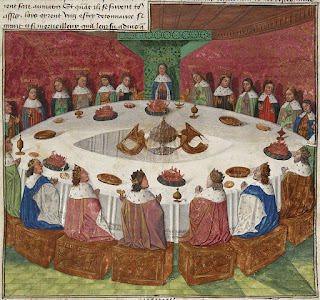While out on loan, the Nanteos Cup, conflated for around the past century with the Holy Grail, the was stolen last summer but is now returned almost one year later, reports the intrepid Atlas Obscura.
 The wooden drinking vessel is reputed to contain a sliver of the True Cross and is imbued with miraculous healing properties and the Welsh Nanteos estate, which it’s named for, will lend it out freely to the sick in hopes of curing them. The Sturm und Drang of Richard Wagner’s Ring Cycle and Parsifal at the turn of the century was what benighted the cup and made it one more of the several hundred candidates (literal and abstract) found in Europe. Whatever the origin, it is nonetheless quite a treasured cup and a quite massive sting operation was launched in Wales, which led to its recovery, concluding with a shadowy, midnight hand-off.
The wooden drinking vessel is reputed to contain a sliver of the True Cross and is imbued with miraculous healing properties and the Welsh Nanteos estate, which it’s named for, will lend it out freely to the sick in hopes of curing them. The Sturm und Drang of Richard Wagner’s Ring Cycle and Parsifal at the turn of the century was what benighted the cup and made it one more of the several hundred candidates (literal and abstract) found in Europe. Whatever the origin, it is nonetheless quite a treasured cup and a quite massive sting operation was launched in Wales, which led to its recovery, concluding with a shadowy, midnight hand-off.
Wednesday 1 July 2015
choose wisely
catagories: ✝️, 🎶, 🏴, myth and monsters, Wikipedia
Tuesday 24 February 2015
five-by-five
brotherly-love: these two siblings have been exchanging a single birthday card for twenty-seven years
 worrywart: the not so obvious benefits of anxieties
worrywart: the not so obvious benefits of anxieties
ewe-net: wifi-enabled sheep aim to create mobile access points for rural Wales
honourable mentions: some of the contenders from Sony’s World Photography Awards
tip of the iceberg: research suggests that the unconscious mind is capable of mental acrobatics we usually associate with conscious deliberation
Monday 14 April 2014
kleinstaaterei
With the level of public will or involvement remaining unclear and the source of dissent an elusive factor—strange to consider in the first place that regions are careening towards the right to assert their independence with only the ultimate goal being to align themselves with another power in sight, the cities of Ukraine, though under the microscope and garnering much attention, do tend to be overlooked, imagined out of context, scale or compartmentalised. Much is being said about psyche and exceptionalism, the economic importance of the industrial eastern part of the country, the need for stability and security thereof with also quite a bit of name-calling, like the US styling of counter insurgency efforts by the government in Kyiv as anti-terror operations or pledges to shore up debts, but there is little in terms, I think, in terms of profiles for these metropolitan cities, which have their own character and history.
catagories: 🇷🇺, 🎓, 🏴, 💱, 🧠, foreign policy, revolution











